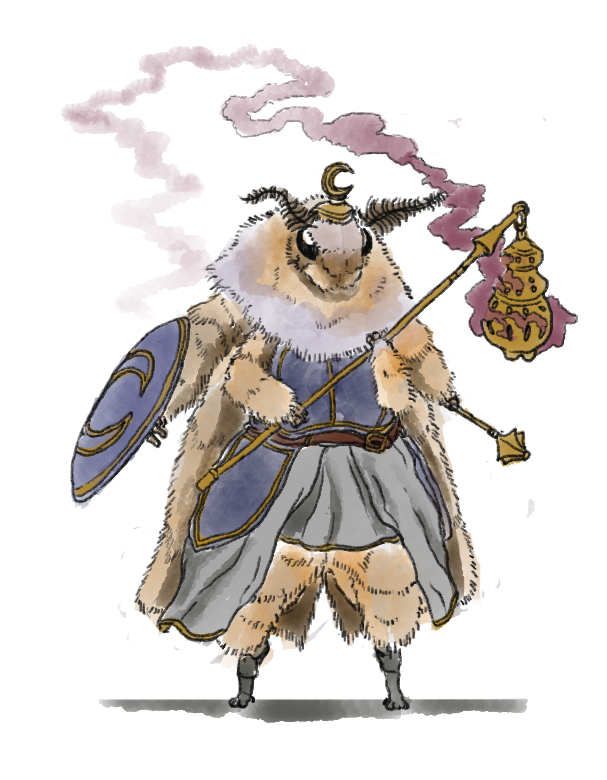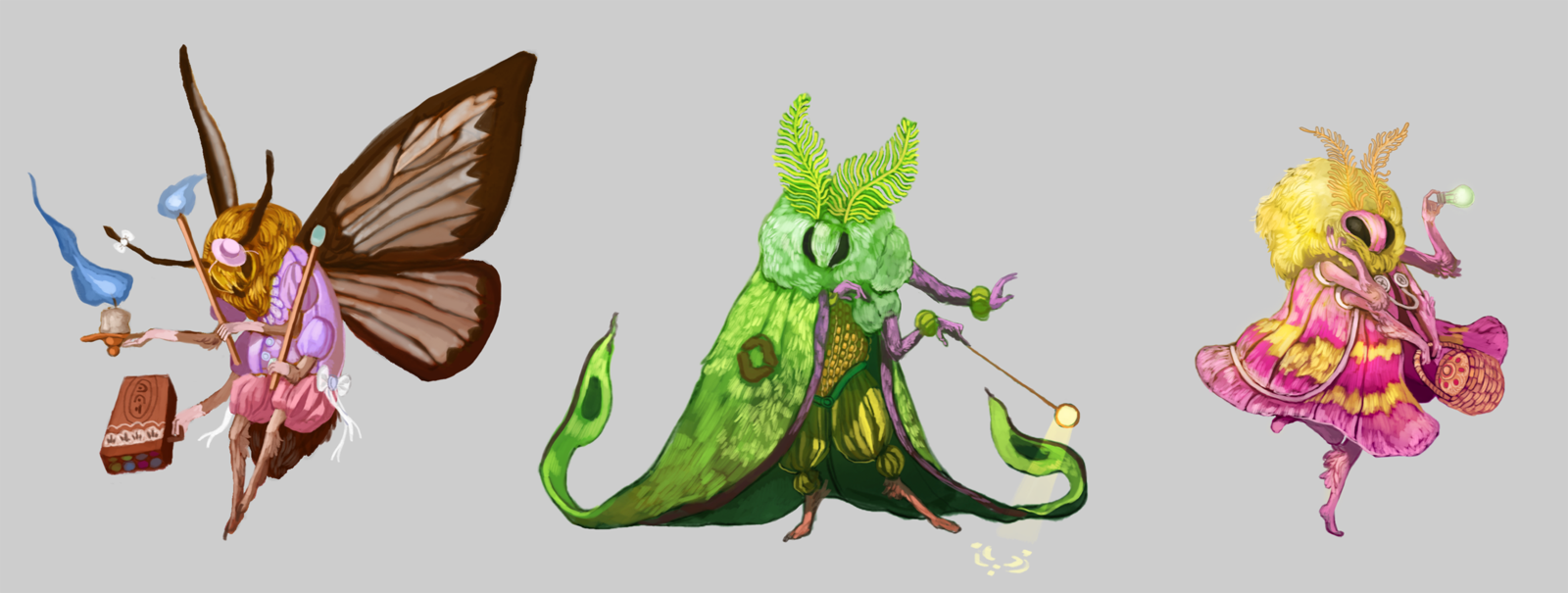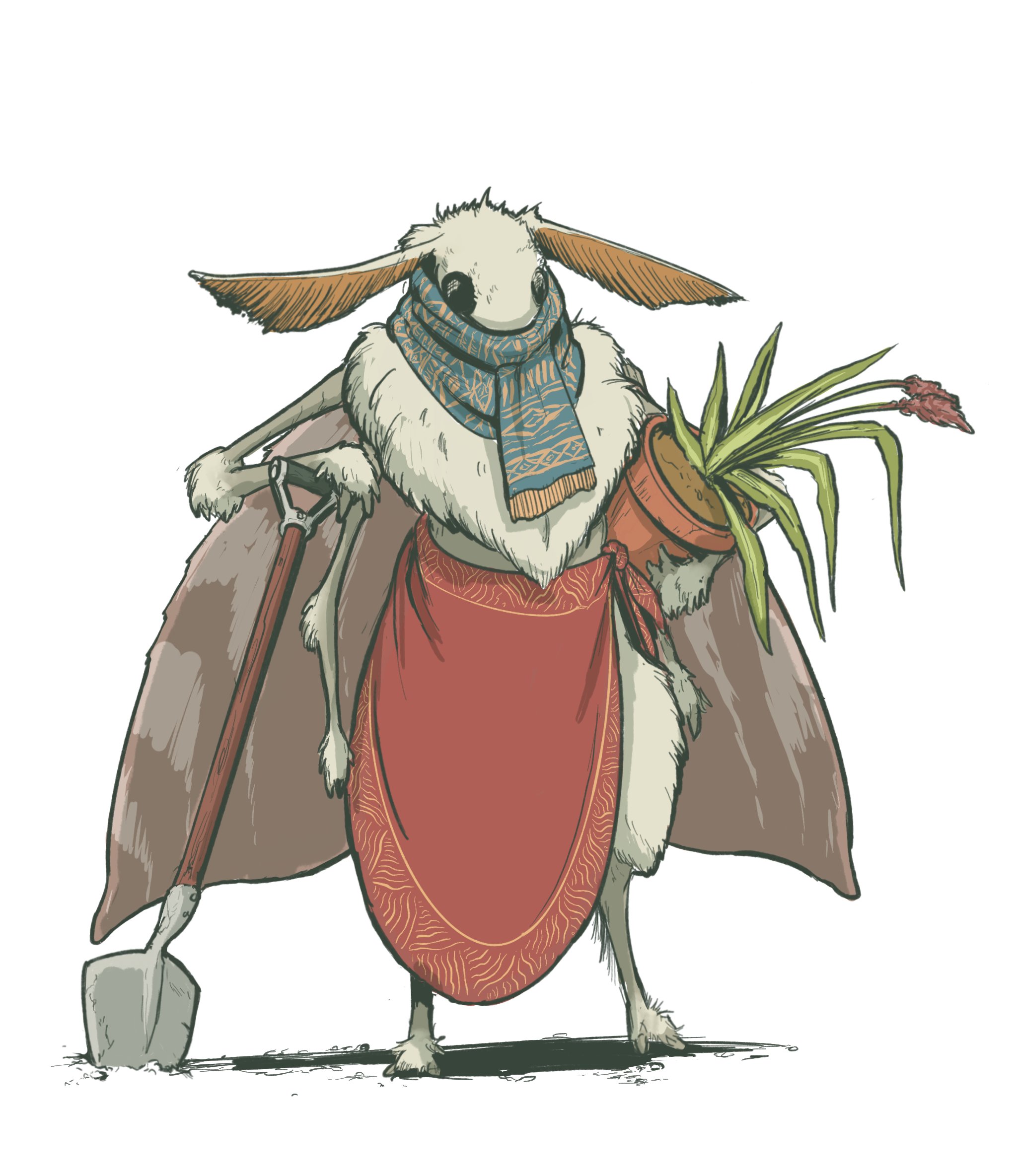Mothfolk, The graceful recluses
Moody and perplexing, isolated and elegant, tough and passionate, the ways in which one might describe the mothfolk are many - although those capable of pronouncing the true name of the species are few and far between. They're a quiet breed with a tendency toward nature - solitary, yet intimate creatures with a penchant for thought and ritual. Often on their feet or in the skies, even the most fierce and untamed of mothfolk carry an attitude of worldly place that comes from their nomadic lifestyle. They owe their lives to the land they come from, and often find themselves responsible for its protection. Pensive, loving, determined, and gentle, the mothfolk are hidden away, but not to be overlooked.
Basic Information
Biological Traits
The appearance of a mothkin is also not something that most are accustomed to. Their large, heavy wings hang around their tall humanoid bodies like cloaks, and their inhuman faces with antennae and compound eyes may prove off-putting to those with strong aversions to all things insectoid. Sometimes covered in fur, these four-armed, three-fingered creatures are the subjects of any countryside myths and legends about giant bugs that stalk the night, preying on children - although these myths vary wildly in truthfulness.
Subraces
All mothfolk share a common ancestor, but there are three distinct groups of mothfolk that roam the world, each with their own customs and abilities. Most live in secluded communities, but some have chosen to engage in the world society.
Luna
Luna mothfolk are by far the most reclusive and mysterious, to the point where in some places they are merely considered the stuff of myth and legend. The greatest philosophers and seers of the mothfolk are found among them, and they carry a deep reverence for nature. Graceful and beautiful creatures, these mothfolk have semi-transluscent wings hued in green, blue, pink, or yellow, and their exoskeletons are covered by a thick coat of soft white fur.
Diamondback
Diamondback mothfolk are the hardiest, most warrior-like breed of moth. With their thick earthen carapaces and slender brown, grey, black, or tan wings, they blend into the rocky deserts and mountains of their origin. Diamondbacks are excellent hunters, trackers, and fighters, with a powerful, armor-like exoskeleton.
Royal
Diplomatic, professional, and never at a loss for words, the Royal moths are by far the most accepted by general society. As their name suggests, many Royals are nobles, diplomats, or negotiators. As a people, they have managed to throw off most of the common misconceptions and elements of the uncanny surrounding mothfolk culture - a large part of this simply due to the fact that most of them simply don't speak Ivathi nor engage in more "mothly" behaviors when around the more "common" folk. The fact that their multicolored wings tend to be emblazoned with beautiful, intricate patterns helps in this as well.
Growth Rate & Stages
Unlike most other common races, mothfolk do not develop as the same creature from when they are born. Mothfolk begin their lives as larvae, often a part of a brood of ten or more. After almost a year of nurturing and feeding from the mother, during which the larvae are largely unaware of their surroundings, the mother helps them prepare coccoons for metamorphosis.
The larvae stay in coccoons for just over half of a year, at which point they finally emerge as moths. From there, they quickly grow over the next three or four years, usually to just over five feet in height, and learn to fend for themselves. They are considered "adults" once their wings have fully developed, at around ten years after emergence, and elders after about thirty-five.
Additional Information
Perception and Sensory Capabilities
Civilization and Culture
Naming Traditions
In most moth cultures, the mother is assigned the task of naming each of her children as they grow. These names will often change at the whim of the mother, and usually do not become official until metamorphosis. Their names are often difficult to pronounce with human tongues, but this does not bother mothfolk, as they lack human tongues. Mothfolk do not have gendered names.
Major Language Groups and Dialects
Mothfolk are a mysterious, reclusive race found in the lost reaches of the world, seldom seen in more "civilized" places. Tall and often silent, mothfolk have a reputation for being cryptic and thoughtful - although in reality many of them stay silent because they know the thrumming, clicking sound of their communication makes the more "normally-speaking" races uncomfortable.
Ivathi is a language native to mothfolk. It is learned and internalized as a larvae and spoken upon emergence. The language is complex and almost impossible to speak with a human mouth, as mothfolk speak with a specialized organ in their throat that other beings lack. Ivathi sounds like a series of squishes, clicks, and chitters, cut with the occasional thrumming or soft vowel. It uses its own alphabet, and translating it to other scripts only results in an approximation of the language's true sound.
Culture and Cultural Heritage
Mothfolk are not the longest-lived of creatures, the very oldest living only until their late fifties. With such a short life, mothfolk have learned to live life to the fullest. Many pursue intellectual or mindful pursuits, becoming librarians or philosophers, pontificating on the nature of life and knowledge itself.
Still others decide to live their relatively brief lives adventuring, seeing the world, becoming as well-traveled and renowned as they can before passing their fortunes on to their children. A common thread throughout most mothfolk, though, is that they are slow to anger. It is instilled in most mothfolk as early as the larval stage, regardless of culture, that life is too short to be spent angry
The true name of the mothfolk race is complex and rich with meaning - the moniker 'mothfolk' was coined by a human. The mothfolk are fine with this, as "Llkllrxzshlkl" is exceedingly difficult to pronounce for those not versed in the language.








Comments